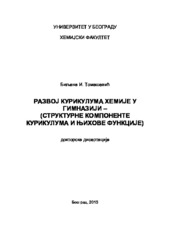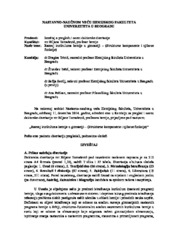Приказ основних података о дисертацији
Развој курикулума хемије у гимназији-(структурне компоненте курикулума и њихове функције)
The development of the chemistry curriculum in grammar school-(the structural components of the curriculum and their functions)
| dc.contributor.advisor | Trivić, Dragica | |
| dc.contributor.other | Tešić, Živoslav | |
| dc.contributor.other | Sovilj, Sofija | |
| dc.contributor.other | Pešikan, Ana | |
| dc.creator | Tomašević, Biljana I. | |
| dc.date.accessioned | 2016-07-10T17:13:40Z | |
| dc.date.available | 2016-07-10T17:13:40Z | |
| dc.date.available | 2020-07-03T10:13:32Z | |
| dc.date.issued | 2015-02-06 | |
| dc.identifier.uri | https://nardus.mpn.gov.rs/handle/123456789/5733 | |
| dc.identifier.uri | http://eteze.bg.ac.rs/application/showtheses?thesesId=3146 | |
| dc.identifier.uri | https://fedorabg.bg.ac.rs/fedora/get/o:11463/bdef:Content/download | |
| dc.identifier.uri | http://vbs.rs/scripts/cobiss?command=DISPLAY&base=70036&RID=47784719 | |
| dc.description.abstract | У оквиру дисертације истраживан је развој гимназијског програма хемије у Србији од 1881. до 2011. године, урађена је структурно-функционална анализа курикулума из осам образовних система (Словеније, Енглеске, Данске, Малте, Северне Каролине, Јуте, Онтарија и Сингапура), испитивано је опште знање наставника о наставним програмима и специфично знање о програмима хемије, као ставови о подршци коју програми пружају за развој и подршку креативности. Структурно-функционална анализа обухватила је рад на документацији (21 примарни документ из домаћих извора и 22 примарна докумената из страних извора). За поступак анкетирања, као инструмент за испитивање знања и ставова наставника о наставним програмима, припремљена су два упитника чија је валидност проверена пре истраживања. Анализа домаћих програма показала је да се број структурних компонената и обим информација које садрже повећавао у сваком новом програму. Први програми су били усмерени на садржај. Та оријентација задржана је и у актуелним гимназијским програмима, иако су у програме додаване нове компоненте, Циљеви, Оперативни задаци, Списак демонстрационих огледа и Лабораторијских вежби, Методска упутства за реализацију програма и Предлози за додатну наставу и слободне активности. Анализа савремених страних курикулума показала је да су према структурним компонентама и одговарајућим информацијама, оријентисани према циљевима, исходима, процесима и контекстима. Испитивање ставова наставника показало је да програме углавном користе за годишње планирање (65,5%), затим за месечно планирање (43,5%), а најмање за планирање појединачних часова (38,7%). У планирању наставници не користе све структурне компоненте, релеванте за одређени ниво планирања и информације које оне пружају. Као најкорисније компоненте наставници су издвојили Оперативне задатке/исходе (55,5%), Циљеве и задатке (46,2%) и Садржаје тема (33,6%). Критички осврт наставника на актуелне програме у Србији показао је да искуснији наставници у већем проценту предлажу додавање нових Циљева и исхода, док млађи наставници у већем проценту имају потребу за конкретизацијом и разрадом постојећих. Савремено образовање очекује од наставника да планира и реализује ситуације које подстичу и развијају креативност ученика. Испитивање у којој су мери наставници за такве активности подржани програмом, показало je да они препознају тај вид подршке (55,0%), а да би им у томе највише помогле додатне информације посредоване кроз Исходе који описују вештине (68,3%) и знања (61,1%), и Препорукe/упутства за реализацију програма (54,5%)... | sr |
| dc.description.abstract | Within the framework of this dissertation, we researched the development of the grammar school chemistry curriculum in Serbia between 1881 and 2011, completed a structural-functional analysis of the curricula of eight educational systems (Slovenia, England, Denmark, Malta, North Carolina, Utah, Ontario and Singapore), investigated the general knowledge of teachers about teaching programmes and their specific knowledge of chemistry programmes, as well as their views of the support that teaching programmes provide to the development and support of creativity. The structural-functional analysis encompassed work on documentation (twentyone primary documents from domestic sources and twenty-two primary documents from foreign sources). Two questionnaires, whose validity was checked beforehand, were prepared for the purpose of conducting a survey, as an instrument for investigating the knowledge and views of teachers concerning teaching programmes. The analysis of domestic programmes showed that the number of structural components and the scope of information that they contain increased with each new programme. The first programmes were focused on the content. That orientation has been maintained in the grammar school programmes currently in use, although new components have been added to them: Aims, Operative tasks, A list of demonstration experiments and Laboratory exercises, Methodological instructions for the realisation of the programme and Proposals for additional teaching activities and free activities. The analysis of contemporary foreign curricula showed that, according to their structural components and the corresponding information, they are oriented towards goals, outcomes, processes and contexts. A survey of the teachers’ views showed that they mostly use the programmes for annual planning (65.5% of them), then for monthly planning (43.5%), and least of all for planning individual classes (38.7%). When it comes to planning, the teachers do not use all the structural components relevant for a particular level of planning and the information that they provide. The teachers surveyed singled out Operative tasks/outcomes (55.5%), Aims and tasks (46.2%) and Topic contents (33.6%) as the most useful components. A critical review of the current programmes in Serbia on the part of the teachers showed that more experienced teachers propose to a higher degree that new Aims and outcomes should be added, whereas a higher percentage of younger teachers feel the need for a concretisation and development of the currently existing ones. Contemporary education requires of the teacher to plan and realise situations that stimulate and develop the students’ creativity. Research into the extent to which teachers are supported by the programme for such activities showed that they recognise that form of support (55.0%), and what they would find most helpful in this respect is additional information mediated through Outcomes that describes skills (68.3%) and knowledge (61.1%), as well as Recommendations/instructions for programme realisation (54.5%)... | en |
| dc.format | application/pdf | |
| dc.language | sr | |
| dc.publisher | Универзитет у Београду, Хемијски факултет | sr |
| dc.relation | info:eu-repo/grantAgreement/MESTD/Basic Research (BR or ON)/179048/RS// | |
| dc.rights | openAccess | en |
| dc.source | Универзитет у Београду | sr |
| dc.subject | наставни програм | sr |
| dc.subject | curriculum | en |
| dc.subject | chemistry curriculum | en |
| dc.subject | chemistry teaching | en |
| dc.subject | curriculum components | en |
| dc.subject | knowledge of curriculum | en |
| dc.subject | creativity | en |
| dc.subject | наставни програм хемије | sr |
| dc.subject | настава хемије | sr |
| dc.subject | компоненте наставних програма | sr |
| dc.subject | знање о наставним програмима | sr |
| dc.subject | креативност | sr |
| dc.title | Развој курикулума хемије у гимназији-(структурне компоненте курикулума и њихове функције) | sr |
| dc.title | The development of the chemistry curriculum in grammar school-(the structural components of the curriculum and their functions) | en |
| dc.type | doctoralThesis | en |
| dc.rights.license | ARR | |
| dcterms.abstract | Тривић, Драгица; Совиљ, Софија; Тешић, Живослав; Пешикан, Aна; Томашевић, Биљана И.; Razvoj kurikuluma hemije u gimnaziji-(strukturne komponente kurikuluma i njihove funkcije); | |
| dc.identifier.fulltext | http://nardus.mpn.gov.rs/bitstream/id/29525/Disertacija3686.pdf | |
| dc.identifier.fulltext | http://nardus.mpn.gov.rs/bitstream/id/29526/Tomasevic_Biljana_I.pdf | |
| dc.identifier.fulltext | https://nardus.mpn.gov.rs/bitstream/id/29525/Disertacija3686.pdf | |
| dc.identifier.fulltext | https://nardus.mpn.gov.rs/bitstream/id/29526/Tomasevic_Biljana_I.pdf | |
| dc.identifier.rcub | https://hdl.handle.net/21.15107/rcub_nardus_5733 |



